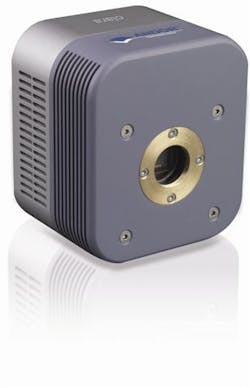CCD cameras from Andor features reduced typical read noise at 1 MHz

The Clara CCD camera, based on measured QC data from the first 200 cameras built, has reduced typical read noise to 2.4 electrons at 1 MHz. Cooling is now offered to -55ºC with an internal fan only (no water required), with -20ºC under fan-off (vibration-free) operation. Features include a 1.3 Mpixel Sony ‘ICX285 sensor, low-noise 10 or 20 MHz readout modes, and data channeled through a USB 2.0 interface.
Andor
Belfast, Northern Ireland
www.andor.com/clara
-----
PRESS RELEASE
Belfast, Northern Ireland, 7 January 2010 – Andor Technology plc (Andor), a world leader in scientific imaging, spectroscopy solutions and microscopy systems, today announced even higher performance from the most sensitive interline CCD camera on the market, the Andor Clara. Based on measured QC data from the first 200 cameras built, Andor are able to reduce the Clara’s typical read noise to 2.4 electrons at 1MHz, representing an unprecedented low detection limit. In addition, Andor are able to report a significant improvement to the cooling performance; the Clara now offers cooling to -55 0C with internal fan only (no water required), complementing an impressive -20 0C under fan-off (vibration free) operation.
The Clara is based around the popular 1.3 Megapixel ‘ICX285’ sensor from Sony® and is engineered to drive the highest sensitivity and dynamic range performance available from a high-resolution scientific interline CCD camera.
Andor’s proven vacuum process, alongside close attention to thermal management, has resulted in the deep air cooling performance, for elimination of darkcurrent, complementing the uniquely low read noise peformance. Dynamic events can be followed with outstanding quantitative stability via low noise 10 or 20 MHz readout modes, the data channeled through a USB 2.0 interface. Andor’s iCam technology and comprehensive I/O functionality enables market-leading acquisition efficiency through live cell microscopy softwares, and an accurate hardware generated timestamp ensures temporal precision. The compact, robust design and accessible SDK, renders Clara ideally suited to OEM integration.
Dr Colin Coates, Product Manager within Andor Technology, said: "Since the launch of Clara in 2009, our customers have expressed tremendous enthusiasm at our capability to drive better performance from an already well established and popular interline sensor. We see this key specification improvement as an important testimony to Andor’s position as the leading manufacturer of high performance scientific cameras”.
For more information, please visit www.andor.com/clara.